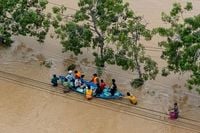Severe flooding in central and southern Vietnam has left a devastating mark on the country, with the official death toll reaching 90 and 12 people still missing as of November 23, 2025, according to the Environment Ministry. Days of relentless rain, landslides, and rising rivers have battered the region since late October, submerging entire communities, destroying infrastructure, and leaving thousands stranded or homeless. The scale of the disaster has forced a massive emergency response and raised fresh concerns about the growing impact of climate change on Vietnam’s weather patterns.
According to The Chenab Times, the brunt of the catastrophe was felt in the mountainous province of Dak Lak, where more than 60 of the fatalities since November 16 occurred after heavy rain triggered landslides and inundated homes. Rainfall in some areas exceeded an astonishing 1,900 millimeters within a single week. Tens of thousands of homes were flooded in Dak Lak alone, and over 235,000 houses were affected across the central region, a vital hub for Vietnam’s coffee production. Four communes in Dak Lak remained underwater on November 23, with authorities struggling to reach isolated residents.
The human toll is tragically illustrated by the story of 61-year-old farmer Mach Van Si, who recounted to AFP how he and his wife were forced to climb onto their sheet-metal rooftop to escape the rising waters. “Our neighborhood was completely destroyed. Nothing was left. Everything was covered in mud,” Si said. For two nights, they remained stranded on the roof, with Si recalling, “I just thought we were going to die because there was no way out.” Their ordeal was echoed by many others in Dak Lak and neighboring provinces, where rescue teams worked around the clock to save those trapped by the floodwaters.
Rescue operations have been extensive and, at times, dramatic. Boats and security forces navigated treacherous currents to evacuate residents from rooftops and treetops in provinces including Gia Lai, Khanh Hoa, and Binh Dinh. Authorities deployed helicopters to airdrop aid to communities completely cut off by flooding and landslides, as reported by Tuoi Tre News. The government mobilized tens of thousands of personnel to deliver clothing, water-purification tablets, instant noodles, and other essential supplies to the most affected areas. Food and water were rushed to flooded hospitals, where patients survived for days on limited rations until help arrived.
The flooding has not only claimed lives but also crippled infrastructure and livelihoods. State media reported that in southern coastal Khanh Hoa province, severe flooding washed away two suspension bridges last week, leaving many households isolated and desperate for assistance. Whole sections of the popular tourist city of Nha Trang were inundated, and deadly landslides struck highland passes around the Da Lat tourist hub, further complicating rescue and relief efforts.
Transport and power networks have suffered significant disruption. On November 23, several locations on national highways remained blocked due to ongoing flooding and landslides, and some railway sections were still suspended, according to the Environment Ministry. The power grid was also hit hard: more than 129,000 customers remained without electricity on November 23, following outages that affected over a million people the previous week.
The economic impact of the floods is staggering. The government estimated total losses at 8.98 trillion dong, or about $341 million, across five provinces. The Environment Ministry put the figure at $343 million, underscoring the immense cost of destroyed homes, damaged infrastructure, and ruined crops. More than 80,000 hectares of rice and other crops across Dak Lak and four other provinces were damaged in just one week. The agricultural sector, already vulnerable, was further battered as over 3.2 million livestock or poultry died or were washed away by floodwaters.
Natural disasters have taken a heavy toll on Vietnam throughout 2025. Between January and October, extreme weather events caused 279 deaths or missing persons and inflicted over $2 billion in damage nationwide, according to the national statistics office. The frequency and intensity of such disasters have left experts and citizens alike deeply concerned about the country’s resilience in the face of a changing climate.
Scientists have pointed to a worrying pattern: human-driven climate change is making extreme weather more frequent and destructive in Vietnam. While the country is no stranger to heavy rain between June and September, the recent floods stand out for their severity and the breadth of their impact. According to AFP, relentless rain has lashed south-central Vietnam since late October, and popular holiday destinations have been hit by several rounds of flooding. The combination of unusually intense rainfall, rapid urbanization, and deforestation has amplified the risks, leaving communities more vulnerable than ever before.
The central region’s role as a major coffee production belt adds another layer of complexity to the disaster’s aftermath. With tens of thousands of homes and large swathes of farmland under water, the livelihoods of countless farmers are at stake. For families like Mach Van Si’s, the loss is not just material but deeply personal—the destruction of homes, communities, and a way of life built over generations.
Government officials have acknowledged the scale of the challenge ahead. While rescue operations continue for the 12 people still missing, attention is already turning to recovery and rebuilding. The immediate priorities include restoring electricity, reopening transport routes, and providing continued support to displaced residents. In the longer term, experts and policymakers are calling for greater investment in flood defenses, early warning systems, and climate adaptation measures to better protect vulnerable regions.
Despite the devastation, stories of resilience and solidarity have emerged. Communities have rallied to support one another, sharing resources and shelter with those who lost everything. Emergency personnel, often working in hazardous conditions, have been widely praised for their dedication and bravery. Yet, as the waters begin to recede, the true scale of the disaster is only just coming into focus—and the road to recovery promises to be long and fraught with challenges.
Vietnam’s experience this year serves as a stark reminder of the mounting risks posed by climate change, particularly for countries on the front lines of extreme weather. As the country counts its losses and begins the slow process of rebuilding, the urgent need for sustainable development and climate resilience has never been clearer.




